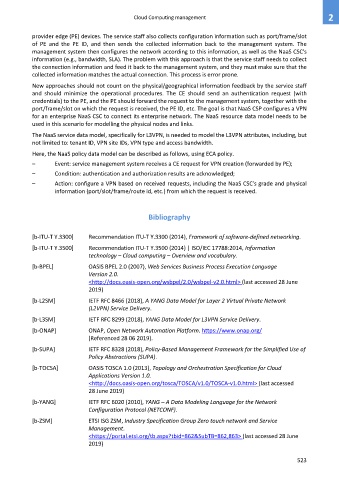Page 531 - Cloud computing: From paradigm to operation
P. 531
Cloud Computing management 2
provider edge (PE) devices. The service staff also collects configuration information such as port/frame/slot
of PE and the PE ID, and then sends the collected information back to the management system. The
management system then configures the network according to this information, as well as the NaaS CSC's
information (e.g., bandwidth, SLA). The problem with this approach is that the service staff needs to collect
the connection information and feed it back to the management system, and they must make sure that the
collected information matches the actual connection. This process is error prone.
New approaches should not count on the physical/geographical information feedback by the service staff
and should minimize the operational procedures. The CE should send an authentication request (with
credentials) to the PE, and the PE should forward the request to the management system, together with the
port/frame/slot on which the request is received, the PE ID, etc. The goal is that NaaS CSP configures a VPN
for an enterprise NaaS CSC to connect its enterprise network. The NaaS resource data model needs to be
used in this scenario for modelling the physical nodes and links.
The NaaS service data model, specifically for L3VPN, is needed to model the L3VPN attributes, including, but
not limited to: tenant ID, VPN site IDs, VPN type and access bandwidth.
Here, the NaaS policy data model can be described as follows, using ECA policy.
– Event: service management system receives a CE request for VPN creation (forwarded by PE);
– Condition: authentication and authorization results are acknowledged;
– Action: configure a VPN based on received requests, including the NaaS CSC's grade and physical
information (port/slot/frame/route id, etc.) from which the request is received.
Bibliography
[b-ITU-T Y.3300] Recommendation ITU-T Y.3300 (2014), Framework of software-defined networking.
[b-ITU-T Y.3500] Recommendation ITU-T Y.3500 (2014) | ISO/IEC 17788:2014, Information
technology – Cloud computing – Overview and vocabulary.
[b-BPEL] OASIS BPEL 2.0 (2007), Web Services Business Process Execution Language
Version 2.0.
<http://docs.oasis-open.org/wsbpel/2.0/wsbpel-v2.0.html> (last accessed 28 June
2019)
[b-L2SM] IETF RFC 8466 (2018), A YANG Data Model for Layer 2 Virtual Private Network
(L2VPN) Service Delivery.
[b-L3SM] IETF RFC 8299 (2018), YANG Data Model for L3VPN Service Delivery.
[b-ONAP] ONAP, Open Network Automation Platform. https://www.onap.org/
(Referenced 28 06 2019).
[b-SUPA] IETF RFC 8328 (2018), Policy-Based Management Framework for the Simplified Use of
Policy Abstractions (SUPA).
[b-TOCSA] OASIS TOSCA 1.0 (2013), Topology and Orchestration Specification for Cloud
Applications Version 1.0.
<http://docs.oasis-open.org/tosca/TOSCA/v1.0/TOSCA-v1.0.html> (last accessed
28 June 2019)
[b-YANG] IETF RFC 6020 (2010), YANG – A Data Modeling Language for the Network
Configuration Protocol (NETCONF).
[b-ZSM] ETSI ISG ZSM, Industry Specification Group Zero touch network and Service
Management.
<https://portal.etsi.org/tb.aspx?tbid=862&SubTB=862,863> (last accessed 28 June
2019)
523

